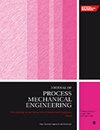利用有限元法进行机器学习,分析表面机械损耗处理合金中的残余应力和塑性变形
IF 2.2
4区 工程技术
Q2 ENGINEERING, MECHANICAL
Proceedings of the Institution of Mechanical Engineers, Part E: Journal of Process Mechanical Engineering
Pub Date : 2024-07-25
DOI:10.1177/09544089241263455
引用次数: 0
摘要
本文提出了一种新颖的机器学习模型,旨在预测金属合金在经过表面机械磨损处理后的残余应力和等效塑性变形。用于训练的数据集是通过对 SS316L、NiTi、Ti64、Al7075 和 AZ31 等各种合金的表面机械磨损处理进行数值模拟而生成的。所建模型的回归分析显示出卓越的预测能力,残余应力的 R² 值高达 0.959,平均等效塑性应变的 R² 值为 0.911,均方根误差值分别为 0.035 和 0.088。此外,对输入特征和输出目标之间相关性的详细研究表明,处理过的样品中残余应力和塑性应变值的增加分别与机器学习模型中加工参数和材料属性权重函数的增加相对应。此外,还提供了一个以 Al7075 为重点的案例研究,展示了该模型有效调整参数以实现特定表面残余应力和塑性应变结果的能力。最终,所提出的模型不仅可以作为输出目标的可靠预测器,还可以作为描述复杂输入输出关系的宝贵工具,从而减少在现实世界中进行试错实验的需要。本文章由计算机程序翻译,如有差异,请以英文原文为准。
Finite element method-enabled machine learning for analysing residual stress and plastic deformation in surface mechanical attrition-treated alloys
This paper presents a novel machine learning model designed to predict residual stress and equivalent plastic deformation in metallic alloys undergoing surface mechanical attrition treatment. The dataset used for training was generated by numerically simulating surface mechanical attrition treatment on various alloys, such as SS316L, NiTi, Ti64, Al7075, and AZ31. The regression analysis of the proposed model exhibits exceptional predictive capabilities, with high R² values of 0.959 for residual stress and 0.911 for average equivalent plastic strain, alongside low root mean square error values of 0.035 and 0.088, respectively. Furthermore, the detailed examination of the correlation between input features and output targets revealed that the increase in values of residual stress and plastic strain in treated samples corresponded with heightened weight functions of processing parameters and material properties, respectively, within the machine learning model. A case study focusing on Al7075 was also provided, demonstrating the model's ability to adjust parameters effectively to achieve specific surface residual stress and plastic strain outcomes. Ultimately, the proposed model not only serves as a reliable predictor for the output targets but also functions as a valuable tool for characterizing the complex input–output relationships, thereby reducing the need for trial and error experimentation in real-world scenarios.
求助全文
通过发布文献求助,成功后即可免费获取论文全文。
去求助
来源期刊
CiteScore
3.80
自引率
16.70%
发文量
370
审稿时长
6 months
期刊介绍:
The Journal of Process Mechanical Engineering publishes high-quality, peer-reviewed papers covering a broad area of mechanical engineering activities associated with the design and operation of process equipment.

 求助内容:
求助内容: 应助结果提醒方式:
应助结果提醒方式:


